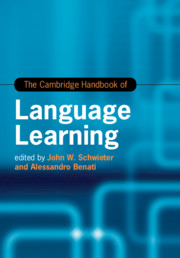Book contents
- The Cambridge Handbook of Language Learning
- Cambridge Handbooks in Language and Linguistics
- The Cambridge Handbook of Language Learning
- Copyright page
- Contents
- Figures
- Tables
- Contributors
- Acknowledgements
- Introduction
- Part I Theories
- Part II Methods
- Part III Skill Development
- Part IV Individual Differences
- 15 Working Memory in L2 Learning and Processing
- 16 Language Aptitudes in L2 Acquisition
- 17 Language Learner Motivation: What Motivates Motivation Researchers?
- 18 A New Look at “Age”: Young and Old L2 Learners
- 19 Identity
- Part V Pedagogical Interventions and Approaches
- Part VI Context and Environment
- Part VII Moving Forward
- Index
- References
19 - Identity
from Part IV - Individual Differences
Published online by Cambridge University Press: 25 June 2019
- The Cambridge Handbook of Language Learning
- Cambridge Handbooks in Language and Linguistics
- The Cambridge Handbook of Language Learning
- Copyright page
- Contents
- Figures
- Tables
- Contributors
- Acknowledgements
- Introduction
- Part I Theories
- Part II Methods
- Part III Skill Development
- Part IV Individual Differences
- 15 Working Memory in L2 Learning and Processing
- 16 Language Aptitudes in L2 Acquisition
- 17 Language Learner Motivation: What Motivates Motivation Researchers?
- 18 A New Look at “Age”: Young and Old L2 Learners
- 19 Identity
- Part V Pedagogical Interventions and Approaches
- Part VI Context and Environment
- Part VII Moving Forward
- Index
- References
Summary
In language learning research, different terms have been used to refer to identity: “self”; “position”; “role”; “subjectivity”; “subject”; and “agent”. Scholars in the 1970s and 1980s interested in this research area tended to draw distinctions between social identity and cultural identity. Social identity referred to the relationship between the learner and the larger social world, mediated through institutions like families, schools, workplaces, social services, and law courts (e.g., Gumperz, 1982). On the other hand, cultural identity referred to the relationship between an individual and members of a particular ethnic group who share a common history and language, and similar ways of understanding the world. Past theories of cultural identity, however, tended to essentialize and reify identities in problematic ways (Atkinson, 1999). In more recent years, the difference between social and cultural identity is seen to be theoretically more fluid, and the intersections between social and cultural identities are considered more significant than their differences. Contemporary identity research has been consistently marked by a social constructionist paradigm that pays attention to the micro-level of interaction and meaning making. Recognizing that identity is socioculturally constructed, educators draw on both institutional and community practices to understand the conditions under which language learners speak, read, and write the target language.
- Type
- Chapter
- Information
- The Cambridge Handbook of Language Learning , pp. 451 - 474Publisher: Cambridge University PressPrint publication year: 2019
References
- 7
- Cited by



